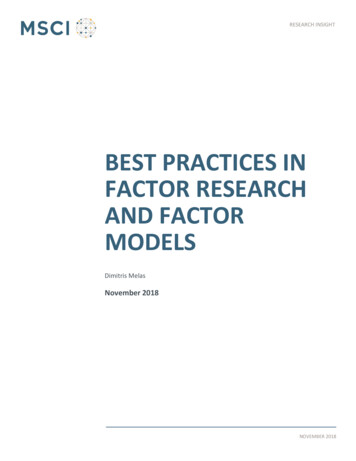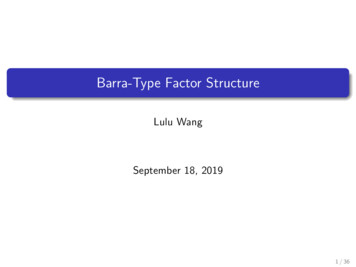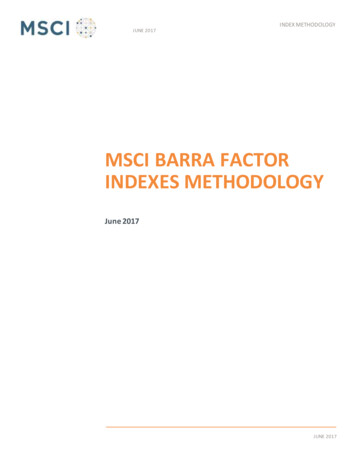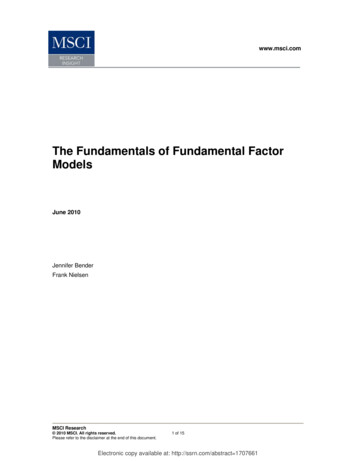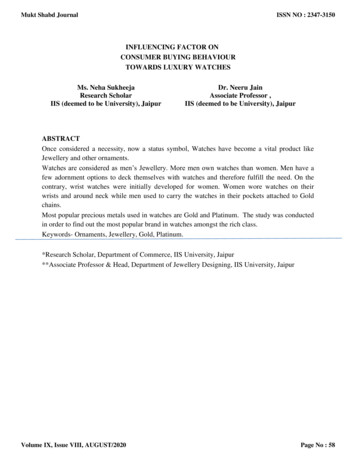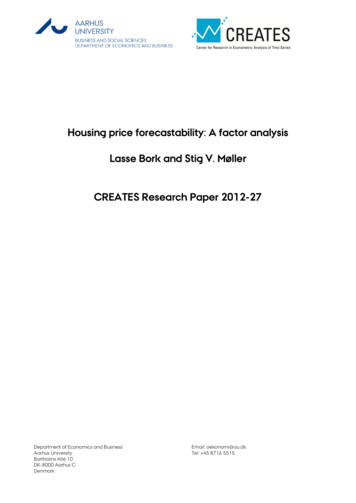
Transcription
Housing price forecastability: A factor analysisLasse Bork and Stig V. MøllerCREATES Research Paper 2012-27Department of Economics and BusinessAarhus UniversityBartholins Allé 10DK-8000 Aarhus CDenmarkEmail: oekonomi@au.dkTel: 45 8716 5515
Housing price forecastability: A factor analysisLasse BorkyStig V. MøllerzMay 2012AbstractWe examine US housing price forecastability using a common factor approachbased on a large panel of 122 economic time series. We nd that a simple threefactor model generates an explanatory power of about 50% in one-quarter aheadin-sample forecasting regressions. The predictive power of the model stays high atlonger horizons. The estimated factors are strongly statistically signi cant according to a bootstrap resampling method which takes into account that the factorsare estimated regressors. The simple three-factor model also contains substantialout-of-sample predictive power and performs remarkably well compared to both autoregressive benchmarks and computational intensive forecast combination models.Keywords: House prices; Forecasting; Factor model; Principal components; Macroeconomic factors; Factor forecast combination; BootstrapJEL codes: C53; E3; G1We gratefully thank Graham Elliott, Carsten Tanggaard, participants at the 2012 Arne Ryde Workshop in Financial Economics, and seminar participants at CREATES, Aalborg University, and AarhusUniversity for comments and suggestions. Møller acknowledges support from CREATES, which is fundedby the Danish National Research Foundation.yDepartment of Business and Management, Aalborg University, Denmark.E-mail:bork@business.aau.dk.zDepartment of Economics and Business, Aarhus University and CREATES. Address: FuglesangsAllé 4, 8210 Aarhus, Denmark. E-mail: svm@asb.dk.
1IntroductionThe recent boom and burst of the U.S. housing market strongly emphasizes that movements in housing prices play a signi cant role for consumer spendings, nancial markets,and the macroeconomy as a whole. It follows that building an adequate forecasting modelcould provide useful information to central banks, nancial supervision authorities as wellas to other economic agents.The existing literature on house price forecastability is in some respects still limited.In particular, the existing evidence tends to focus on long-run trends in house prices.The focus also tends to be on only a single or a few selected house price indicators ata time such that a very narrow information set is used to generate forecasts of houseprices. Valuation ratios (e.g., price-to-rent or price-to-income ratios) are among the mostcommonly used predictors of future house prices. These ratios work well as predictivevariables at long horizons, but they are not necessarily useful at shorter horizons.1 Usingonly a single or a few selected variables at a time to some extent appears ine cientwhen predicting future house prices because movements in house prices may re‡ect manydi erent sources of information. Therefore, it may be possible to obtain more accuratehouse price forecasts by conditioning on a rich information set instead of only a fewvariables.Motivated by the above, this paper examines the ability to forecast real house prices atshort and long horizons using a common factor approach in which we employ informationfrom a very large number of macroeconomic and nancial time series. The basic idea is to1See, for example, Campbell et al. (2009) and Gallin (2008) for in-depth analyses of the predictivepower of the price-rent ratio.2
summarize a large amount of information in a relatively small number of estimated factorsand, as the next step, we use these estimated factors to forecast housing price ‡uctuations.In this way, we are able to make use of a much richer information set in comparison toprevious studies on housing price forecastability. Essentially, the methodology that weapply in this paper enables us to condition the house price forecasts on a large informationset involving more than 100 macroeconomic and nancial variables. This is in sharpcontrast to the typical predictive regression where only up to about a handful of observedvariables is included in the predictor set. The key to embedding such a large informationset in the regressions derives from a factor analysis of the panel where a few latent commonfactors are shown to describe the majority of the variation of the series in the panel. Thefactor analysis thus makes it possible to e ectively reduce the dimension of the predictorset while still being able to summarize and use the underlying information in the panel.Furthermore, Stock and Watson (2002a, 2008) nd that the common factor approach isrobust to structural instability that often plagues predictive regressions because of themany di erent sources of information that shape each factor.Based on a large panel of 122 economic time series, we show that the estimatedcommon factors contain substantial information about future movements in real houseprices. In particular, a three-factor model is able to explain as much as around 50%of the variation in one-quarter ahead growth rates in real house prices. The predictivepower also stays high at longer forecasting horizons. The three predictive factors can beinterpreted as an economic activity, an in‡ation, and an interest rate factor. FollowingGospodinov and Ng (2011), we conduct inference using a bootstrap procedure to addresspotential statistical issues originating from our use of estimated regressors and to take into3
account possible time series dependencies in the predictive regressions. The bootstrapresampling method suggests that the three factors are generally strongly statisticallysigni cant.Our results are robust using both in-sample and out-of-sample forecasting regressions.In the out-of-sample forecasting, we compare with richly parameterized autoregressivemodels, and the simple three-factor model consistently beats the autoregressive benchmark across all forecasting horizons. This holds true when taking into account announcement delays of the macroeconomic series. We also conduct out-of-sample forecastingusing a factor forecast combination approach in which optimal weights are recursivelychosen based on criteria such as the past forecasting performance. Again, the resultsshow that utilizing information from the large panel of economic series leads to smallerforecast errors than autoregressive benchmarks. In addition, we nd that the simplethree-factor model works remarkably well in comparison to the computational intensiveforecast combination models.Focusing on the very volatile period around the recent boom and burst of the housingmarket, we nd that the three-factor model contains useful information in the sense thatit predicts with the right sign. Admittedly, the model does not fully capture the verylarge growth rates around the peak of the house price boom, but it does predict positivegrowth rates, i.e., the sign of the forecast is correct. Likewise, the model does not fullycapture the sharp decline in house prices when the crash occurred, but it does predictnegative growth rates. Thus, also when the crash occurred, the model gets the directionright.4
Related literature. Case and Shiller (1989, 1990) were the rst to document thathousing prices do not follow a random walk. They show that housing returns exhibitpositive autocorrelation and that various information variables predict future housingreturns. Many recent studies examine predictability in the housing market using theprice-rent ratio, which is analogous to the price-dividend ratio often used to forecast thestock market. Gallin (2008) examines the long run relationship between house pricesand rents and nds that they are cointegrated and that the price-rent ratio containsuseful information for predicting housing returns at long horizons. Favilukis et al. (2012)develop a general equilibrium model of the housing market, and their model impliesthat a high price-rent ratio predicts low future housing returns. They provide empiricalevidence consistent with this implication. Campbell et al. (2009) and Cochrane (2011)also give empirical evidence that a high price-rent ratio is a signal of low future housingreturns. Our focus is to forecast the growth in house prices conditioning on a large andmore general information set. We nd that using the large panel of economic time seriesgives much better out-of-sample predictive power relative to using the price-rent ratio.Actually, we nd that the price-rent ratio performs worse than the historical mean inout-of-sample regressions, i.e., just like Goyal and Welch (2003, 2008) document that theprice-dividend ratio is not able to beat the historical mean when forecasting stock returnsout-of-sample.As an exception, Rapach and Strauss (2009) examine housing price forecastabilityusing more than just a single or a few selected predictors. They analyze di erences inhousing price forecastability across the 20 largest U.S. states in terms of population. Oneof their ndings is that the degree of predictability is lower in states with high average5
house price growth (i.e., coastal states) than in states with low average price growth(i.e., interior states). As the focus of our paper is to forecast national house prices andnot to examine the cross-sectional variation in forecasting power across regions, we onlyinclude national variables in our panel, and this also allows us to base our forecasts on amuch larger set of economic variables. Speci cally, we use 122 national economic series,while Rapach and Strauss (2009) only use 16. Exploiting a richer information set whenforecasting house prices could potentially be very important as it intuitively should leadto more accurate forecasts, and it makes it possible to more fully examine the degree ofpredictability in housing prices. Another important di erence is that our sample periodincludes the 2007 crash and the subsequent volatile period in the housing market.The empirical methodology that we apply in this paper to predict housing returnshas also been used to predict stock returns (Ludvigson and Ng 2007) and to predict bondreturns (Ludvigson and Ng 2009, 2011). The innovative methodological feature of ourpaper is that we also consider factor forecast combination and use a bootstrap resamplingmethod to take into account that the factors are estimated regressors.The rest of the paper is organized as follows. Section 2 describes our empiricalmethodology, section 3 provides empirical results, and section 4 concludes.2Empirical methodologyIn this section, we rst describe how we estimate the factors using asymptotic principalcomponent analysis. Then we describe how we run predictive regressions in which thepredictor set includes time series of common factors from the factor analysis.6
2.1Factor model and the estimation of factorsIn recent years, factor models have become a standard tool in applied macroeconomicsand nance. Essentially, when the number of random sources of variation is less than thenumber of dependent variables, then a factor model enables the researcher to reduce thedimension of the number of explanatory variables to a few latent factors. Since the rstgeneration of (exact) factor models by Geweke (1977) and Sargent and Sims (1977), aconsiderable amount of research has been devoted to the econometric theory and empirical analysis of large dimensional dynamic factor models. In particular, building on theapproximate factor model of Chamberlain and Rothschild (1983), the large dimensionalapproximate dynamic factor model is introduced by Forni, Hallin, Lippi and Reichlin(2000, 2004, 2005) in the frequency domain and by Stock and Watson (2002a, 2002b)in the time domain.2 They estimate the large dimensional dynamic factor model nonparametrically by dynamic and static principal component methods, respectively, butrecently these models have also been estimated by Bayesian methods (Otrok and Whiteman 1998; Kim and Nelson 1999) as well as by maximum likelihood methods (Doz,Giannone and Reichlin 2011a, 2011b; Jungbacker and Koopman 2008).In our forecast analysis and similar to Ludvigson and Ng (2007, 2009, 2011), weimplement the static principal component method of Stock and Watson because thismethod is fast, easy to implement, and given the sample size we consider, this methodalso performs similarly well compared to dynamic principal components (Boivin and Ng2By ’large’we mean large in the cross-section, i.e., large in the number of time series (N ), and largein the number of observations (T ) of the time series; for instance N 100 and T 100 depending onthe frequency of the data. By ’approximate’we refer to the relaxation of the iid error term assumptionin the exact factor model such that the error terms are allowed to be weakly (locally) correlated, cf.Chamberlain and Rothschild (1983).7
2005) as well as maximum likelihood methods (Doz, Giannone and Reichlin 2011a). Wenow brie‡y describe the static principal component method, and for this purpose wepresent the dynamic factor model.2.1.1Dynamic factor modelConsider a panel of observable economic variables Xi;t ; where i denotes the cross-sectionunit, i 1; :::; N , while t refers to the time index, t 1; :::; T: The panel of observedeconomic variables is transformed into stationary variables with zero mean and unit variance and denoted by xi;t : The key implication of the dynamic approximate factor modelis that the variation of each of the N observed variables can be decomposed into a common component,component,t.t,that captures the cross-sectional comovement and an idiosyncraticFurthermore, the cross-sectional comovement of the variables is entirelydriven by r N common factors denoted Ft through series speci c factor loadings,i.For the ith variable we write:xi;t where Ft is an r1 vector,iis an ri;t i Fti;t i;t(1)1 vector of factor loadings for the ith observedvariable, and where the idiosyncratic comp
CREATES Research Paper 2012-27 . Housing price forecastability: A factor analysis Lasse Borky Stig V. Młllerz May 2012 Abstract We examine US housing price forecastability using a common factor approach based on a large panel of 122 economic time series. We –nd that a simple three-factor model generates an explanatory power of about 50% in one-quarter ahead in-sample forecasting regressions .
